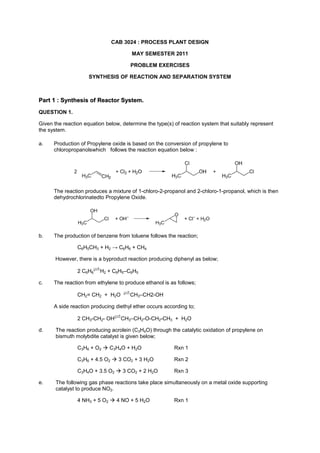
Cab 3024 reactor synthesis problem exercise
- 1. CAB 3024 : PROCESS PLANT DESIGN<br />MAY SEMESTER 2011<br />PROBLEM EXERCISES<br />SYNTHESIS OF REACTION AND SEPARATION SYSTEM<br />Part 1 : Synthesis of Reactor System.<br />QUESTION 1.<br />Given the reaction equation below, determine the type(s) of reaction system that suitably represent the system.<br />a.Production of Propylene oxide is based on the conversion of propylene to chloropropanolswhich follows the reaction equation below :<br />The reaction produces a mixture of 1-chloro-2-propanol and 2-chloro-1-propanol, which is then dehydrochlorinatedto Propylene Oxide.<br />b. The production of benzene from toluene follows the reaction;<br />C6H5CH3 + H2 -> C6H6 + CH4<br /> However, there is a byproduct reaction producing diphenyl as below;<br />2 C6H6H2 + C6H5–C6H5<br />c.The reaction from ethylene to produce ethanol is as follows;<br />CH2= CH2 + H2O CH3–CH2-OH<br />A side reaction producing diethyl ether occurs according to;<br />2 CH3-CH2- OHCH3–CH2-O-CH2-CH3 + H2O<br />d.The reaction producing acrolein (C3H4O) through the catalytic oxidation of propylene on bismuth molybdite catalyst is given below;<br />C3H6 + O2 C3H4O + H2ORxn 1<br />C3H6 + 4.5 O2 3 CO2 + 3 H2ORxn 2<br />C3H4O + 3.5 O2 3 CO2 + 2 H2ORxn 3<br />e.The following gas phase reactions take place simultaneously on a metal oxide supporting catalyst to produce NO2.<br />4 NH3 + 5 O2 4 NO + 5 H2ORxn 1<br />2NH3 + 1.5 O2 N2 + 3 H2ORxn 2<br />2NO + O2 2NO2 Rxn 3<br />4 NH3 + 6 NO 5N2 + 6 H2ORxn 4<br />QUESTION 2<br />Given the following parallel reaction equation below;<br />A B order of reaction = n1<br />A P order of reaction = n2<br />A S order of reaction = n3<br />P is the desired product while B and S are the byproducts of the parallel reaction.<br />For the following cases of reaction orders, select the type of reactors and the level of concentration to be maintained in the reactor in order to maximise selectivity.<br />a.n1 = 1, n2 = 2, n3 = 3<br />bn1 = 2, n2 = 3, n3 = 1<br />c.n1 = 3, n2 = 1, n3 = 2<br />QUESTION 3<br />Under ultraviolet radiation, reactant A with a concentration of CA0 = 10 kmol/m3 decomposes to produce product and byproducts as follows.<br />A RrR = 16 CA 0.5 kmol/m3.min<br />A SrS = 12 CA kmol/m3.min <br />A TrT = CA 2 kmol/m3.min<br />We wish to design a reactor set up that would be suitable for the following cases;<br />a.Product R is the desired material<br />bProduct S is the desired material<br />c.Product T is the desired material<br />QUESTION 4<br />Acrolein (C3H4O) is produced through the catalytic oxidation of propylene on bismuth molybdite catalyst as given below;<br />C3H6 + O2 C3H4O + H2ORxn 1<br />C3H6 + 4.5 O2 3 CO2 + 3 H2ORxn 2<br />C3H4O + 3.5 O2 3 CO2 + 2 H2ORxn 3<br />The reactions are all first order in olefin and independent of oxygen and of reaction products. The ratios of the rate of reactions for the 3 reactions are given below;<br />k2/k1 = 0.1 and k3/k1 = 0.25 <br />The temperature of the reactor has to be kept at maximum of 460 C without the use of cooling.<br />i.Recommend the most suitable reactor and discuss why.<br />ii.Supposed if all the reactions are reversible, suggest the possible additional enhancements on the operation of the reactor which could be applied in order to maximise the production of Acrolein.<br />QUESTION 5<br />Reactant A decomposes through three simultaneous gas phase reactions to form three products namely B, C and D. The three reactions and their corresponding rate laws are as below;<br />A B Reaction 1 : rB= 0.0012 exp 26,000 1300- 1TCA<br />A C Reaction 2 : rC= 0.0018 exp 25,000 1300- 1TCA1.5<br />A D Reaction 3 : rD= 0.00452 exp 5,000 1300- 1TCA0.5<br />If the desired product is B and its production has to be maximised;<br />i.Select the suitable reactor and justify your answer.<br />ii.Discuss qualitatively the setting for concentration and and temperature in the reactor that will further enhance the production of B.<br />QUESTION 6<br />Given the van de Vusse elementary reactions as below;<br />A B C<br />2A D<br />where : <br />k1 – rate of reaction producing B from A, 0.01 s-1<br />k2 – rate of reaction for the reversible reaction producing A from B, 0.05 s-1<br />k3 – rate of reaction producing C from B, 10 s-1<br />k4 – rate of reaction producing D from A, 100 m3/kmol<br />i.Determine the reactor or combination of reactors that will maximise the amount of B formed together with the setting of temperature and concentration of the reactor.<br />What other measures could be implemented to further improve the selectivity of product A over the other byproducts.<br />